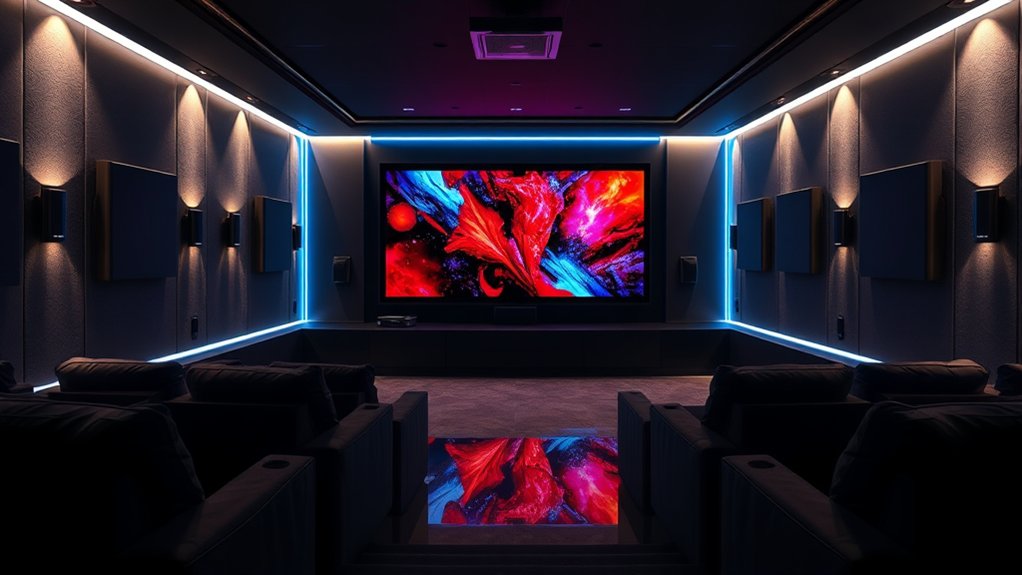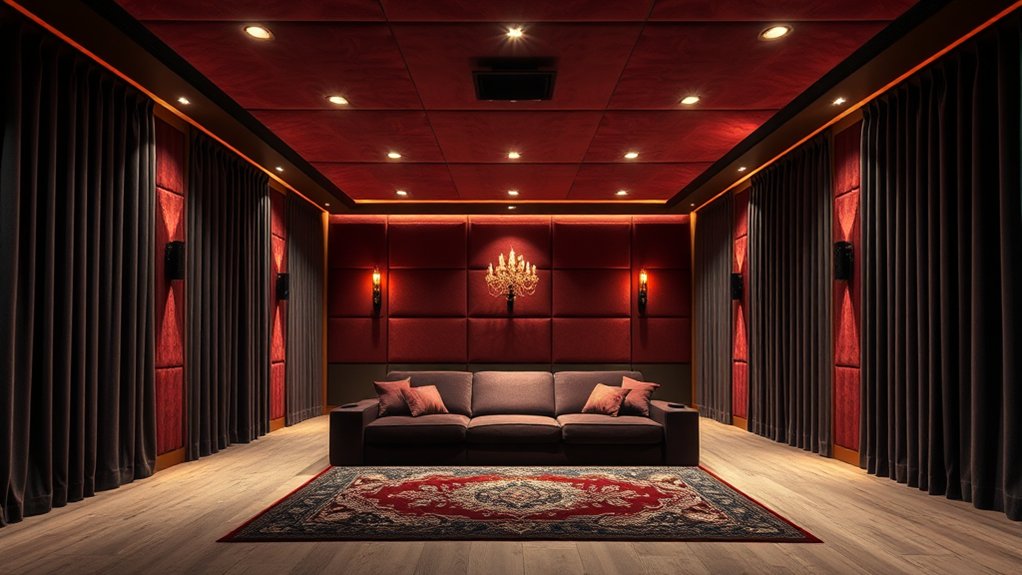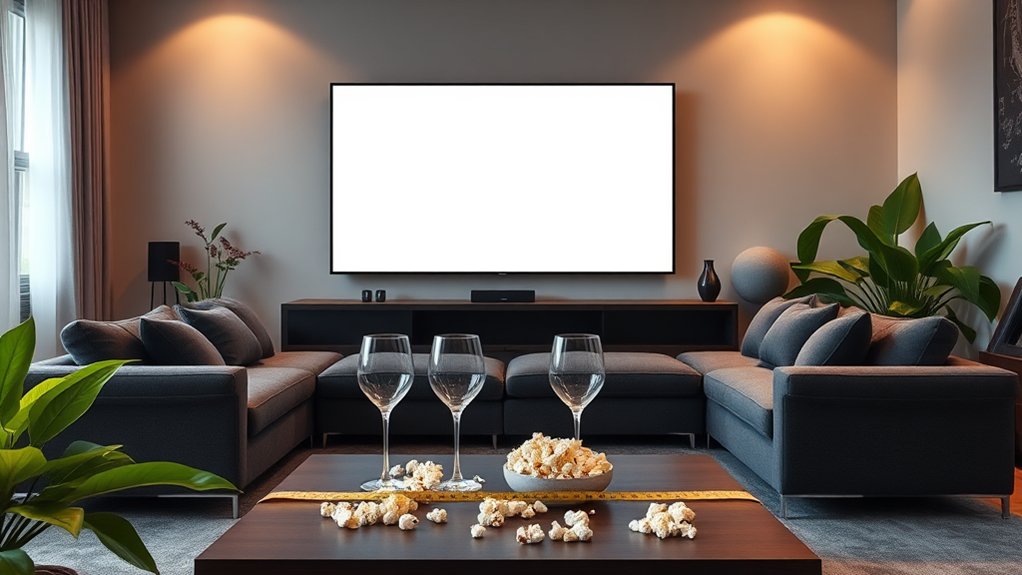To create a stunning high-contrast home theater, start by optimizing your room—think blackout curtains and dimmable LED lights for that perfect ambiance. Next, pick the right projector, like D-ILA or laser models, which improve deep blacks and vivid colors. Calibrate for maximum contrast using tools to tweak brightness levels, and select a quality screen that absorbs light, such as a neutral gray option. Don’t forget, modern projectors have neat settings to heighten your viewing experience. Wouldn’t you want to know more about them?
Key Highlights
- Use matte dark colors for walls and ceilings to minimize light reflection and enhance contrast in your home theater.
- Choose a D-ILA or SXRD projector for exceptional contrast ratios and deep blacks, resulting in a more cinematic experience.
- Select a neutral gray screen to improve black depth and maintain brightness, ensuring a dynamic display without washed-out images.
- Calibrate your projector professionally to optimize brightness and contrast, achieving the best possible image quality for vivid visuals.
- Activate advanced features like dynamic contrast and iris control to enhance real-time brightness adjustments and overall picture quality.
Optimize Your Room Environment
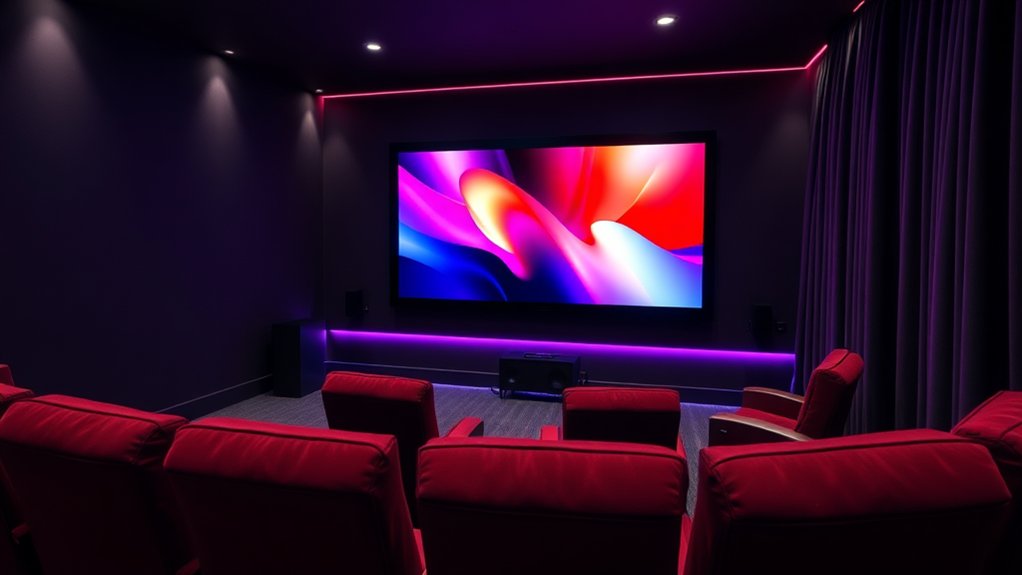
When you’re setting up your home theater, it’s crucial to keep in mind that the environment around you can make or break your viewing experience.
Start by controlling room lighting; blackout curtains are your best friends, blocking out sunlight that wants to intrude on your cinematic bliss. Integrate dimmable LED lighting to create the right mood without glare. Additionally, investing in a quality soundbar that offers immersive audio technologies can significantly enhance your overall audio experience.
Controlling room lighting with blackout curtains and dimmable LEDs sets the perfect cinematic mood for your home theater.
Think about wall and ceiling treatments too—matte dark colors absorb light better than glossy ones, which reflect it like an annoying disco ball. Additionally, ensure seating arrangement allows for adequate distance from the screen to mitigate room modes and bass peaks. A well-designed space with optimal room dimension ratios will greatly enhance your audio and visual experience.
Furthermore, consider your seating arrangement; a little distance from the back wall can go a long way in reducing bass buildup.
In the end, a well-optimized room means sharper visuals and clearer sound, ensuring your movie nights are just that—nights.
Choose the Right Projector Technology
Choosing the right projector technology is like picking the perfect tool for a job; the right choice can improve your home theater experience from good to spectacular. If you crave breathtaking visuals, consider D-ILA or SXRD projectors, with fantastic contrast ratios and deep blacks—perfect for movie nights. On a budget? DLP projectors offer sharp images but may lack that dramatic contrast you seek. Want brightness? LCD options are available, but beware of washed-out blacks! For longevity and stability, laser projectors are worth the investment, shining bright for years. Additionally, projectors like the Epson Pro Cinema LS12000 deliver high brightness levels and advanced features, enhancing your viewing experience. Remember, brightness levels often range from 800 to 3000 lumens, so choose according to your room size and ambient light. Each technology has its pros and cons, but knowing your viewing environment and preferences will help you make an informed decision. After all, what’s a home theater without stunning visuals?
Calibrate for Maximum Contrast
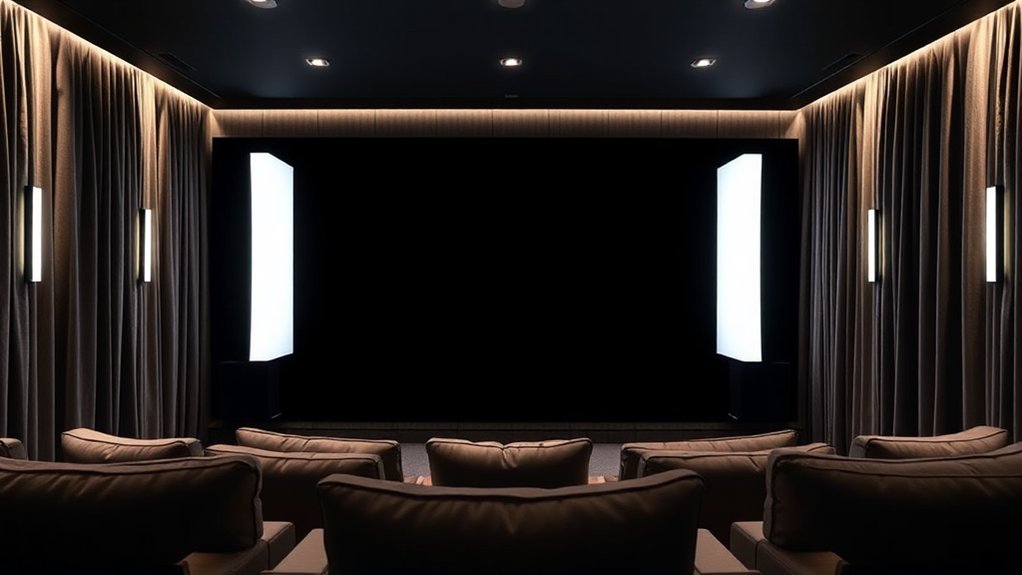
In any home theater setup, achieving maximum contrast isn’t just a luxury; it’s essential for bringing movies to life in the most engaging way.
Start with calibration tools, like professional software such as HCFR, which help you adjust brightness and contrast accurately. Use test patterns to find the sweet spot for peak white and black levels—aim just below digital level 235 to avoid losing highlight details.
As you tweak the settings, keep in mind that brightness defines blacks and contrast impacts white levels, directly affecting dynamic range.
Finally, keep your environment dark; after all, wouldn’t you want your epic battle scenes to shine without the annoying glare of ambient light ruining the drama?
Select High-Quality Screens
Selecting high-quality screens can make or break your home theater experience, and the right choice often hinges on multiple factors that greatly affect your viewing pleasure.
For starters, consider the screen material; high-gain options improve brightness as ambient light-rejecting surfaces elevate contrast in well-lit rooms.
Although bigger screens can immerse you, they might wash out images if your projector isn’t bright enough—so balance is key.
Don’t overlook screen color either; neutral gray can deepen blacks compared to standard white.
Finally, confirm your screen’s frame is tensioned to prevent wrinkles, and consider how installation affects light exposure.
After all, who wants to watch a movie with distractions ruining the show? It’s all about striking that perfect balance!
Leverage Advanced Features and Settings
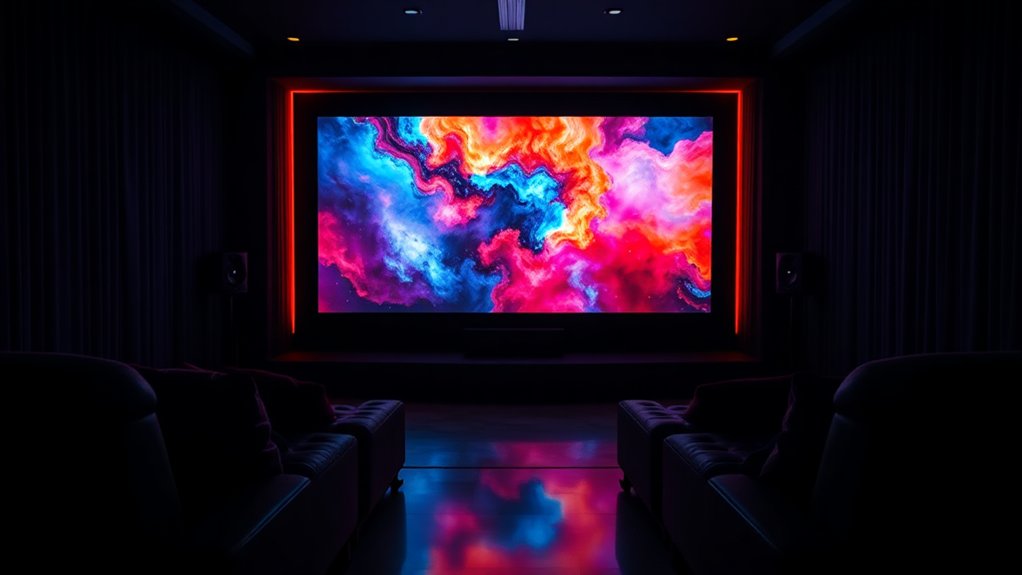
Once you’ve selected a high-quality screen that suits your home theater needs, the next step is to take full advantage of the advanced features and settings of your projector.
First, activate dynamic contrast and iris control; they adjust brightness in real-time, ensuring dark scenes look rich without oversaturating highlights.
Have you tried HDR and color management settings? Using projectors with HDR support and wide color gamut options can truly elevate your viewing experience.
Don’t forget about high refresh rates—120 Hz is a game-changer for smoother visuals, making even the most intense scenes enjoyable.
Regularly check for firmware updates, as they’ll improve performance.
Your projector’s advanced features are waiting to transform movie nights into cinematic experiences; are you ready?
Frequently Asked Questions
What Are the Best Wall Colors for Enhancing Contrast?
To improve contrast, you should consider deep colors like black or dark gray. They absorb light, minimize glare, and create a vivid display, making your viewing experience more immersive and enjoyable. Choose matte finishes for best results.
How Does Room Size Affect Contrast in Home Theaters?
Room size affects contrast by influencing screen placement and viewing distance. Smaller rooms may limit size and create reflections, whereas larger rooms require careful ambient light management to preserve image quality and guarantee ideal viewing experiences.
Can Outdoor Lighting Impact Home Theater Contrast Levels?
Yes, outdoor lighting can greatly impact your home theater’s contrast levels. Even minimal ambient light intruding into your space can wash out colors and blacks, making it essential to control light sources effectively.
How Often Should I Calibrate My Projector for Best Performance?
You should recalibrate your projector every 1-2 years to maintain ideal performance. If you notice color shifts, decreased brightness, or blurry images, it’s definitely time to adjust and get the best viewing experience.
Do Different Content Types Affect Perceived Contrast Differently?
Yes, different content types affect perceived contrast distinctly. Dark movies improve depth and detail, whereas bright sports highlight color vibrancy. Games utilize dynamic lighting, and presentations focus on clarity, making contrast perceptions vary considerably.

